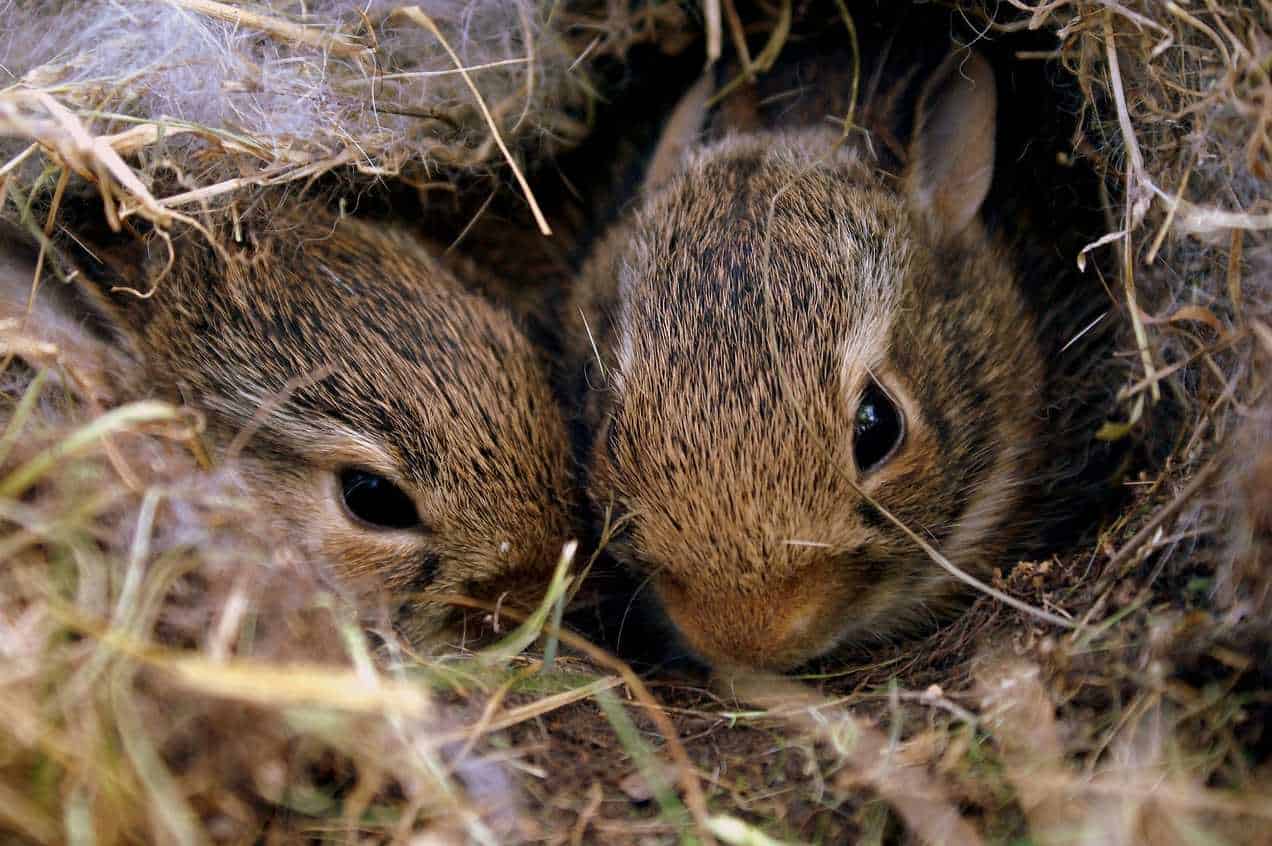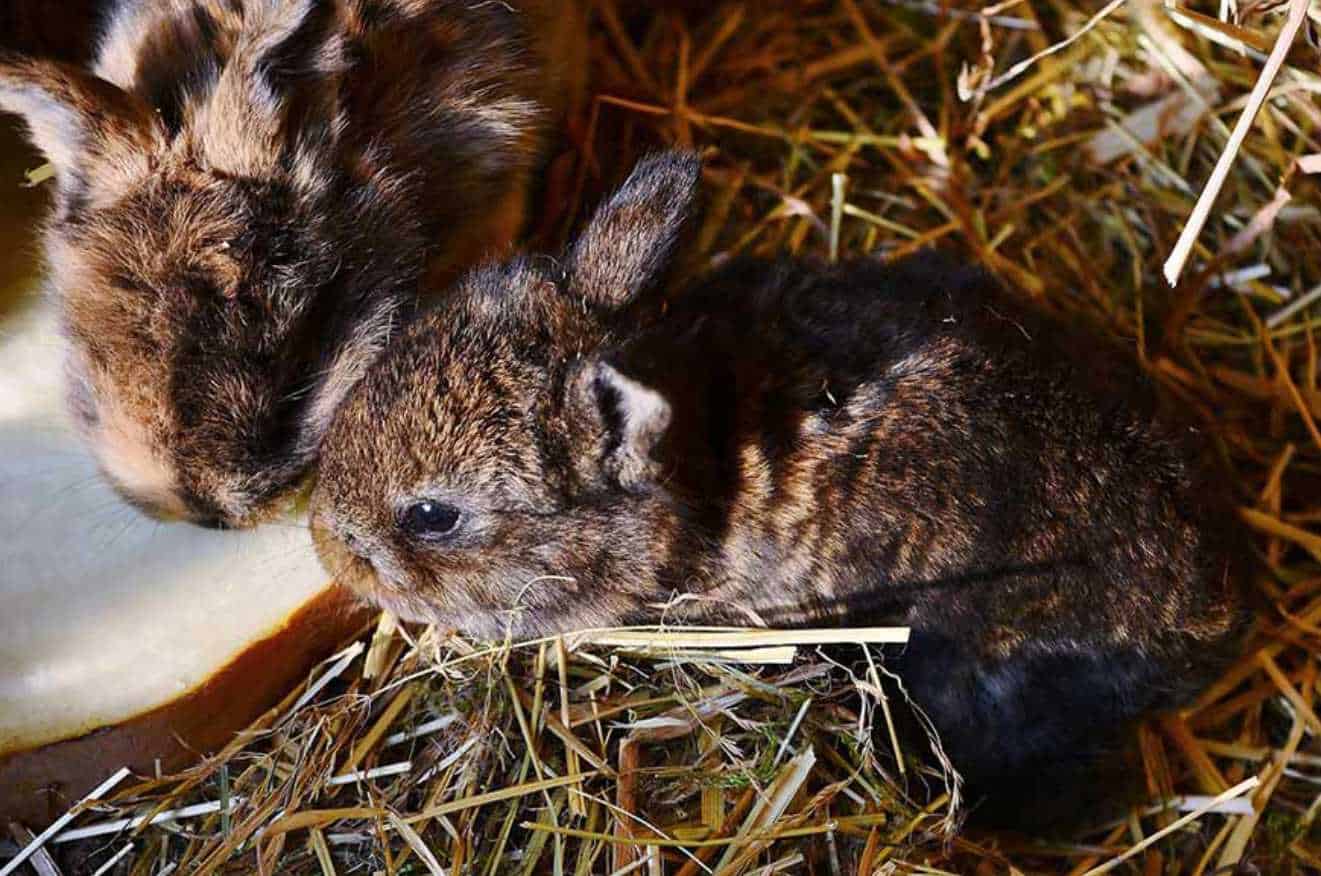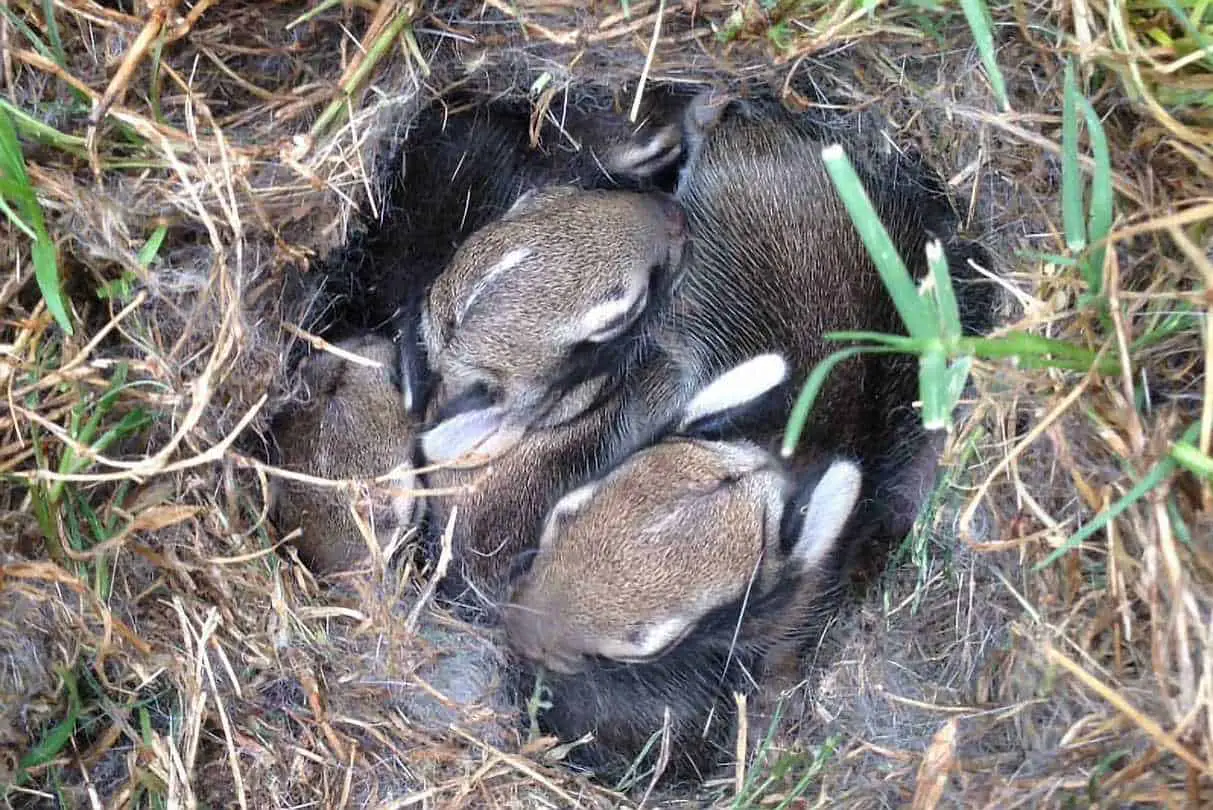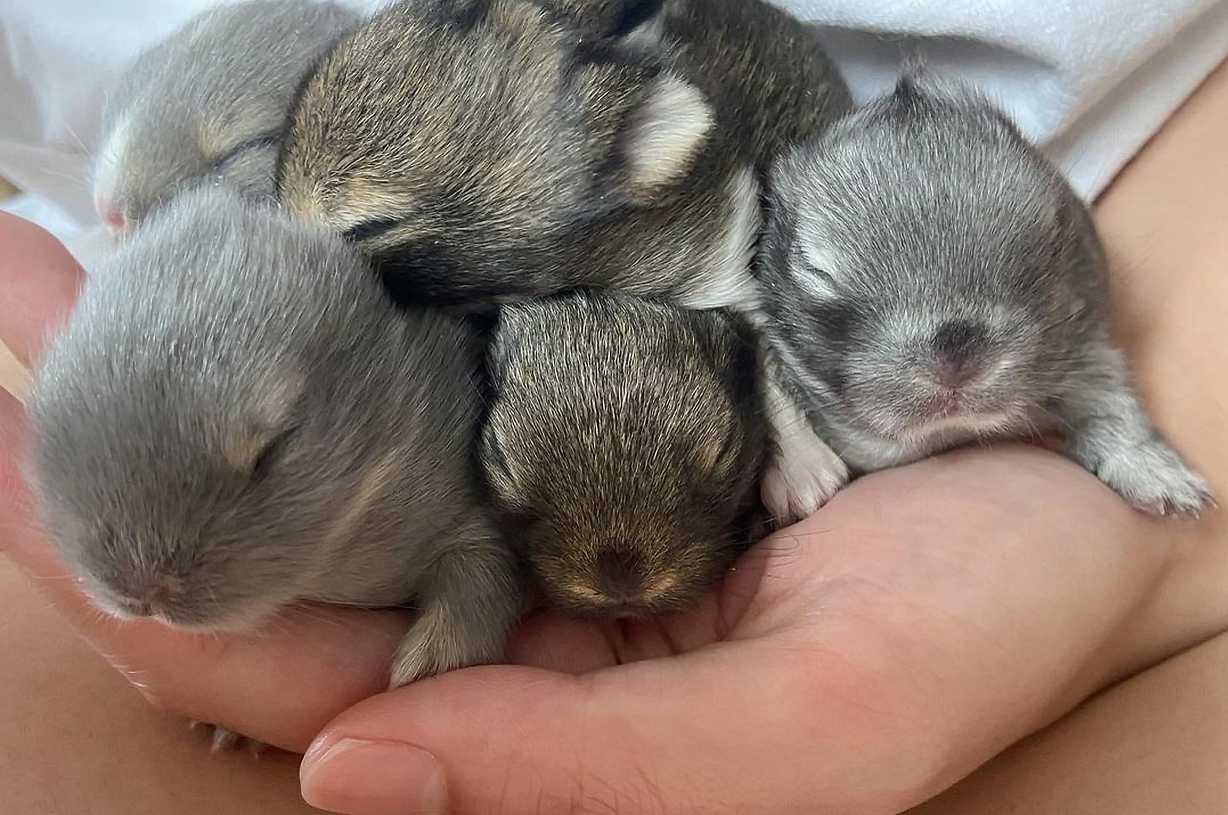There are many reasons one might not know how old a baby rabbit is. You can either be rescuing rabbits from the wild or have just discovered that your beloved pet has kits all over the place. Whatever the reason might be, here are six ways to tell how old a baby rabbit is.
1. Size and Weight of the Baby Rabbit
No. of Days | Size | Weight |
Newborn (1-2 Days) | 2 inchesv | 1-1.5 oz. |
One week (5-10 Days) | 3-4 inches | 6-8 oz |
Two to Three Weeks (11-21 Days) | 4-5 inches | 16-24 oz. (1-1.5 lbs.) |
Four to Five Weeks (22-30 Days) | 5-7 inches | 24-28 oz. (1.5-1.75 lbs.) |
Six to Seven Weeks (40-50 Days) | 7-10 inches | 32-48 oz (2-3 lbs.) |
Maturity (6 Months) | 12 inches and up | 64-80 oz. (4-5 lbs.) |
7 months and up | 12 inches and up | 96-32o oz. (6-20 lbs.) |
The size and weight of the baby rabbit are some of the various ways you can tell how old it is.
Most of the time, newborn kits are only around two inches in size and one to one and a half ounces in weight. They mostly fit inside the palm of an adult human and are very light, comparable to kittens.
The rabbit will double in size and weight by the time it reaches a week old. The size and weight will start an upward trend in the following six to seven weeks, where they will instantly double in size.
Baby rabbits grow rapidly in their first two months and approach their adult size around the seventh month.
Of course, these estimated sizes will vary from breed to breed. Kits from giant breeds such as Angora or Flemish can double or even triple in size compared to standard rabbits like a cottontail.
If you want a more comprehensive way to tell the rabbit’s age, let’s get into the other method.
2. Body Development Present
No. of Days | Body Development Present |
Newborn (1-2 Days) | ● No furs present ● Closed Eyes and Ears |
One week (5-10 Days) | ● Closed Eyes ● Droopy and Closed Ears ● Minimal Fur |
Two to Three Weeks (11-21 Days) | ● Eyes are open but blind ● Erect Ears but deaf ● Fur starts to grow more rapidly |
Four to Five Weeks (22-30 Days) | ● Gaining Senses ● More active |
As weight and size can vary, you can recognize the rabbit’s age by combining it with other signs such as body features. The body development of rabbits is almost similar for every breed, leading to more accurate results.
When a rabbit is less than a week old, they don’t have any fur. The feature of hairlessness applies to all rabbits, even with hairy breeds, such as Angora. Their eyes and ears are also closed and non-receptive.
In the wild, the hairlessness nature of the kits is very advantageous as it leads to little to no lead for predators. They are also quiet, especially when buried under their nest.
As they reach their first week, the kits will grow minimal fur. The thickness of the coat can vary from breed to breed, but most of the time, they are around a quarter to half an inch long. The unique colors and patterns of the coat will also start to show.
At two to three weeks, their eyes will slowly open but are non-receptive or blind. The same applies to the ears, which will stand erect in their head.
Their fur will also grow more rapidly and the pattern, marking, and color will be a lot clearer. They can also start to go out of their nest and the surrounding areas.
At four to five weeks, they will gain their hearing and see the world for the first time. It’s also when they will start to forage and explore their surroundings. During this period, the rabbits are capable to leave their nest and find food without help from their mother.
3. Baby Rabbit’s Behavior
The rabbit’s behavior will vary a lot based on their age. Newborns are quiet and huddle around inside the nest with their siblings.
They will start to move more as they reach around two to three weeks. Even though their senses are not fully developed, the rabbits will start to wander around and be more active. They will wean and show signs of interest in hay and grass.
By around four weeks, they can mostly survive alone in the wild.
4. Diet of the Rabbit
Initially, the kit’s diet consists mostly of milk from the mother, later transitioning to hay and grass. In the first two weeks, the baby rabbit will get their sustenance only from the mother rabbit’s milk. Their digestive system is not fully capable of processing any food yet.
The milk from their mother is also packed with nutrients and antibodies, perfect for the growth of baby rabbits. If the kits are fed right, they have more chances to fight off diseases and develop a healthy body.
Around two to three weeks, rabbits might show an interest in hay and grass. Their nest is lined with dried grass and plant materials. The kits will start to chew on the parts of their nest, even with their less receptive senses.
They will also start to wander off from the nest, albeit stay near it. If the mother rabbit is around, it will help the baby rabbits with foraging and food.
After a week or two, the rabbits will become fully capable of foraging and finding food alone. They could also add other plant materials such as leaves and flowers to their diet.
5. Habitat
If you find the kits buried inside a nest, it’s most likely that they are around less than three weeks old. Baby rabbits inside the nest mostly get their food from the mother rabbit. The milk from their mother is the only source of sustenance.
When the rabbit is around two weeks old, it may start to explore and wander around the nearby area of the nest. However, since their senses and foraging skills are not capable yet, they can’t get far away from the nest.
On week three, the rabbits will have better senses. They might wander farther away but probably still stay close to their nest.
The place where the kits are found can vary a lot. Domestic rabbits might not have the proper bedding and spot to make a nest and have their baby in an open space. It’s a very stressful process for mother rabbits and might result in eating and harming their young.
If you suspect your rabbit might be pregnant, it’s best to provide her with the proper place and materials to make her nest. You can also buy a manufactured nest designed for domestic does.
6. Take the Rabbit to the Vet
One of the best ways to ensure that you can have an accurate estimate of the baby rabbit’s age is by bringing them to the vet. The veterinarian will have ample resources and knowledge to have the correct estimation of the kit.
Knowing the age of the baby rabbit is crucial as it’s the time when owners can lay the building blocks for a healthy and active adult rabbit.
Providing the wrong care by their age can lead to various issues for the rabbit in the long run. By knowing their proper age, rabbit owners can provide them with the right nutrition and aid for the kits.
What are the Signs that People Should Intervene with the Baby Rabbits?
Abandoned Kits
Most mother rabbits do not abandon their young. Although it may look like the baby rabbits are buried in the nest and uncared for, it’s for their safety. Unlike other domestic animals, mother rabbits don’t stick around to feed and nurture their young.
Most of the time, the mother rabbit feeds her litter once or twice a day, during waking hours. This evolutionary trait is in place to deter as much prey as possible.
If you stumbled on a nest and want to make sure the kit is not a victim of abandonment, here are the signs you can look for:
- Disturbed Entrance
- Injuries
- Mites or Flea Infestation
- Malnourished Kits
Dead Mother Rabbit
If you get the information that the mother of a litter is dead, it’s a crucial reason to intervene. You can bring the kits to a rabbit sanctuary or the vet to have them examined and provided with the proper care possible.
The Mother Rabbit Is Sick or Injured
When the doe is too weak or sick to take care of the kits, you can intervene by providing them with the right baby formula and guiding the doe to a better health condition. Rabbits are very quick to grow, so you might have to do the manual feeding for just one to two weeks.
Touching the litter is only advisable for domestic rabbits as they have a sense of bond with their owners. Doing this in the wild can increase the stress on the mother doe.
There is a common misconception that mother rabbit will abandon their young when touched by humans. It’s a misconception with a hint of truth. If the mother rabbit is not used to your smell, it might perceive you as a predator and be stressed.
However, these cases mostly happen in the wild and not with domestic rabbits.
Conclusion
There are many reasons one might want to determine a rabbit’s age, whether for adopting a new rabbit or finding abandoned babies in the wild. We hope this article about how to tell how old a rabbit is helped you tremendously.



